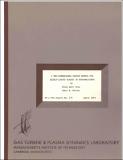A two-dimensional design method for highly-loaded blades in turbomachines
Author(s)
Dang, Thong Quoc
Download68927451.pdf (3.333Mb)
Alternative title
Highly-loaded blades in turbomachines, A two-dimensional design method for
Other Contributors
Massachusetts Institute of Technology. Department of Aeronautics and Astronautics
Metadata
Show full item recordAbstract
A practical design method for highly-loaded blades in an isolated cascade is presented in this thesis. The flow is assumed to be incompressible and inviscid. The upstream inlet flow condition is taken to be uniform. The present goals of this research are to provide a practical numerical code for the design problem, and a non-linear theory which can be easily expanded to three-dimensions. The theory is based in part on the Clebsh formulation. The blade profile is determined iteratively through the blade boundary conditions using a "smoothing" technique. A practical numerical code is presented for the design problem using "partial smoothing". The program gives very fast convergence solutions with satisfactory accuracy for practical solidity range. A practical design method for highly-loaded blades in an isolated cascade is presented in this thesis. The flow is assumed to be incompressible and inviscid. The upstream inlet flow condition is taken to be uniform. The present goals of this research are to provide a practical numerical code for the design problem, and a non-linear theory which can be easily expanded to three-dimensions. The theory is based in part on the Clebsh formulation. The blade profile is determined iteratively through the blade boundary conditions using a "smoothing" technique. A practical numerical code is presented for the design problem using "partial smoothing". The program gives very fast convergence solutions with satisfactory accuracy for practical solidity range.
Description
Includes bibliographical references Also issued as: Thesis (M.S.)--Massachusetts Institute of Technology, Dept. of Aeronautics and Astronautics, 1983.
Date issued
c1983Publisher
c1983
Series/Report no.
GT & PDL report ; no. 173.